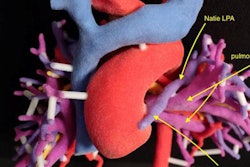Dear AuntMinnie Member,
A controversy has erupted in the U.K. following revelations that nearly half a million women did not receive notifications to attend breast screening.
As reported on our sister site AuntMinnieEurope.com, the snafu is the result of a computer error that began in 2009 and affected women in the national breast screening program, which covers those ages 50 to 70. As a result, women did not receive notices to attend their final breast screening exam.
The effect of the omission is still being analyzed, but U.K. Health Secretary Jeremy Hunt said yesterday that as many as 270 women could have died prematurely as a result of not getting screened. Read our story by clicking here.
The tragic irony of the crisis is that it occurs even as pundits in the U.S. continue to wrangle over the effectiveness of mammography screening. Indeed, yet another study was published this week harping on the need to "educate" women about the "harms" of breast screening, particularly among women 40 to 49. Read all about it by clicking here.
If you read between the lines, the subtext behind this week's study is the rising frustration among mammography skeptics that women continue to seek out breast screening despite "harms" such as biopsy and false-positive exams. If women can only be "properly educated," their argument goes, then perhaps breast screening rates can be driven down to levels acceptable to epidemiologists and biostatisticians.
In actuality, women appear to be fully cognizant of the benefits and harms of breast screening and are voting with their feet to continue getting mammography. As evidenced by the crisis in the U.K. this week, you only realize how much you truly value something until it's gone.
New gadolinium contrast labeling
Meanwhile, the U.S. Food and Drug Administration has issued new product labeling for gadolinium-based contrast agents (GBCAs) for MRI scans. The new labeling is the result of a regulatory process that began last year as the agency struggles to deal with the controversy over gadolinium retention in patients who were given the agents.
There isn't anything earth-shattering in the new labeling, but it does address the agency's conclusion that different types of GBCAs have different levels of gadolinium retention, with patients who were given linear-based agents retaining more gadolinium than those who received macrocyclic agents. Read more by clicking here, or visit our MRI Community.
Radiologist recruiting and pay
Finally, visit our Imaging Leaders Community for a new column on how to recruit radiologists by Daniel Corbett of recruiting firm Radiology Business Solutions. Mr. Corbett outlines the five keys to effective recruiting and hiring, which you can read by clicking here.
While you're in the community, be sure to check out this story on salaries among healthcare professionals. A survey based on self-reported data from LinkedIn found that radiologists occupied the No. 10 spot on a list of the highest-paid professionals.
Get these stories and more in the community by going to leaders.auntminnie.com.



















